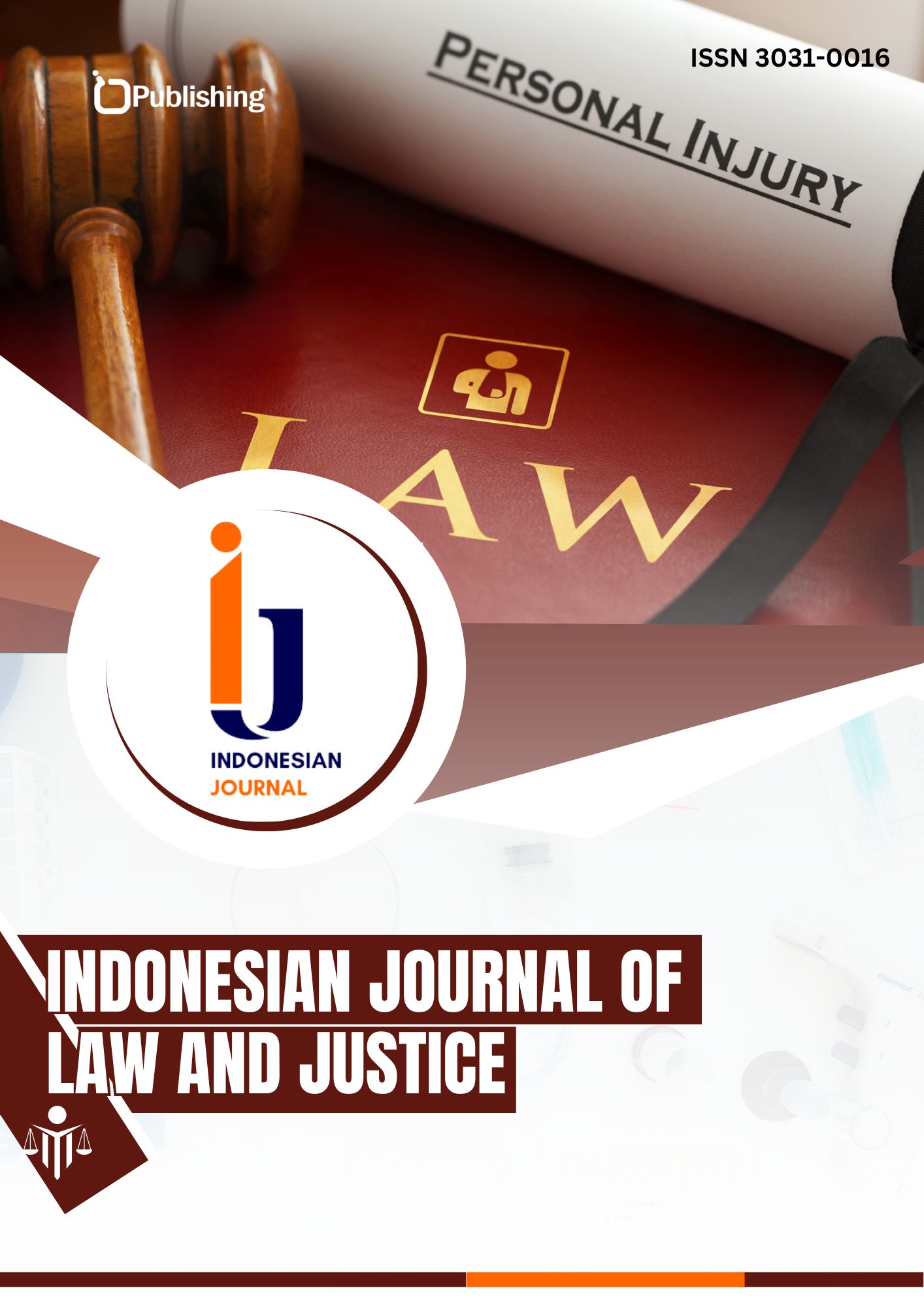Analisis Hukum Eksploitasi Anak Sebagai Pengamen dan Pengemis (Studi Tentang Peran Serta Tanggung Jawab Orang Tua)
DOI:
https://doi.org/10.47134/ijlj.v1i1.1983Keywords:
Children, Law, ExploitationAbstract
Children are a gift and responsibility given by God, thus they need to be protected and respected in their basic rights. Child protection is enshrined in the 1945 Constitution and the United Nations child rights convention. Children are the support for the future of the nation and family. Protection for children should commence from within the womb until they reach the age of 18. It is the responsibility of parents, families, and the community to protect the rights of children, while the state and government need to provide facilities and access for the growth and development of children. Child exploitation, such as begging, is a serious problem. The level of poverty is one of the main causes of exploitation. The state and government have an obligation to protect children from exploitation. However, there are still many street children who are vulnerable to exploitation, including physical, economic and sexual exploitation. This research uses a normative legal and empirical juridical approach. In this research, we will explore child protection arrangements in Indonesia, the factors that cause child exploitation, and their impact on children's welfare, with a case study of Decision Number 623/PID.SUS/2016/PN.MLG. With these efforts, we can better understand child protection and the impact of exploitation on child welfare in Indonesia.
References
Arief, B. N. (1998). Beberapa Aspek Kebijakan Penegakan dan Pengembangan Hukum Pidana. Citra Aditya Bakti.
Babchishin, K. M. (2018). Child Sexual Exploitation Materials Offenders: A Review. European Psychologist, 23(2), 130–143. https://doi.org/10.1027/1016-9040/a000326 DOI: https://doi.org/10.1027/1016-9040/a000326
Buller, A. M. (2020). Systematic review of social norms, attitudes, and factual beliefs linked to the sexual exploitation of children and adolescents. Child Abuse and Neglect, 104. https://doi.org/10.1016/j.chiabu.2020.104471 DOI: https://doi.org/10.1016/j.chiabu.2020.104471
Digidiki, V. (2018). Sexual abuse and exploitation of unaccompanied migrant children in Greece: Identifying risk factors and gaps in services during the European migration crisis. Children and Youth Services Review, 92, 114–121. https://doi.org/10.1016/j.childyouth.2018.02.040 DOI: https://doi.org/10.1016/j.childyouth.2018.02.040
Dwi, I. (2018). Penerapan Hukum Dalam Kasus Kekerasan Seksual Terhadap Anak. MediaPressindo.
Fraley, H. (2018). School nurses’ awareness and attitudes toward commercial sexual exploitation of children. Advances in Nursing Science, 41(2), 118–136. https://doi.org/10.1097/ANS.0000000000000197 DOI: https://doi.org/10.1097/ANS.0000000000000197
Franchino-Olsen, H. (2021). Vulnerabilities Relevant for Commercial Sexual Exploitation of Children/Domestic Minor Sex Trafficking: A Systematic Review of Risk Factors. Trauma, Violence, and Abuse, 22(1), 99–111. https://doi.org/10.1177/1524838018821956 DOI: https://doi.org/10.1177/1524838018821956
Gillespie, S. M. (2018). An Evaluation of a Community-Based Psycho-Educational Program for Users of Child Sexual Exploitation Material. Sexual Abuse: Journal of Research and Treatment, 30(2), 169–191. https://doi.org/10.1177/1079063216639591 DOI: https://doi.org/10.1177/1079063216639591
Greenbaum, J. (2018). Child Sex Trafficking and Commercial Sexual Exploitation. Advances in Pediatrics, 65(1), 55–70. https://doi.org/10.1016/j.yapd.2018.04.003 DOI: https://doi.org/10.1016/j.yapd.2018.04.003
Harjono, D., & SH, M. C. L. (2008). Konstitusi Sebagai Rumah Bangsa. Sekjen Dan Kepanitraan Mahkamah Konstitusi.
Henshaw, M. (2018). Demographic, mental health, and offending characteristics of online child exploitation material offenders: A comparison with contact-only and dual sexual offenders. Behavioral Sciences and the Law, 36(2), 198–215. https://doi.org/10.1002/bsl.2337 DOI: https://doi.org/10.1002/bsl.2337
Hornor, G. (2018). Commercial Sexual Exploitation of Children: Health Care Use and Case Characteristics. Journal of Pediatric Health Care, 32(3), 250–262. https://doi.org/10.1016/j.pedhc.2017.11.004 DOI: https://doi.org/10.1016/j.pedhc.2017.11.004
Laird, J. J. (2020). Demographic and Psychosocial Factors Associated with Child Sexual Exploitation: A Systematic Review and Meta-analysis. JAMA Network Open, 3(9). https://doi.org/10.1001/jamanetworkopen.2020.17682 DOI: https://doi.org/10.1001/jamanetworkopen.2020.17682
Lanctôt, N. (2020). Nightmares and flashbacks: The impact of commercial sexual exploitation of children among female adolescents placed in residential care. Child Abuse and Neglect, 100. https://doi.org/10.1016/j.chiabu.2019.104195 DOI: https://doi.org/10.1016/j.chiabu.2019.104195
Le, P. T. D. (2018). Health Issues Associated with Commercial Sexual Exploitation and Sex Trafficking of Children in the United States: A Systematic Review. Behavioral Medicine, 44(3), 219–233. https://doi.org/10.1080/08964289.2018.1432554 DOI: https://doi.org/10.1080/08964289.2018.1432554
Lefevre, M. (2019). “Both/And” Not “Either/Or”: Reconciling Rights to Protection and Participation in Working with Child Sexual Exploitation. British Journal of Social Work, 49(7), 1837–1855. https://doi.org/10.1093/bjsw/bcy106 DOI: https://doi.org/10.1093/bjsw/bcy106
Mansur, D. M. A., & Gultom, E. (2007). Urgensi Perlindungan Korban Kejahatan: Antara Norma dan Realita. Divisi Buku Perguruan Tinggi, RajaGrafindo Persada.
Merdian, H. L. (2018). Fantasy-Driven Versus Contact-Driven Users of Child Sexual Exploitation Material: Offender Classification and Implications for Their Risk Assessment. Sexual Abuse: Journal of Research and Treatment, 30(3), 230–253. https://doi.org/10.1177/1079063216641109 DOI: https://doi.org/10.1177/1079063216641109
Panlilio, C. C. (2019). Assessing risk of commercial sexual exploitation among children involved in the child welfare system. Child Abuse and Neglect, 87, 88–99. https://doi.org/10.1016/j.chiabu.2018.07.021 DOI: https://doi.org/10.1016/j.chiabu.2018.07.021
Quayle, E. (2020). Prevention, disruption and deterrence of online child sexual exploitation and abuse. ERA Forum, 21(3), 429–447. https://doi.org/10.1007/s12027-020-00625-7 DOI: https://doi.org/10.1007/s12027-020-00625-7
Ramiro, L. S. (2019). Online child sexual exploitation and abuse: A community diagnosis using the social norms theory. Child Abuse and Neglect, 96. https://doi.org/10.1016/j.chiabu.2019.104080 DOI: https://doi.org/10.1016/j.chiabu.2019.104080
Robinson, G. (2019). Working County Lines: Child Criminal Exploitation and Illicit Drug Dealing in Glasgow and Merseyside. International Journal of Offender Therapy and Comparative Criminology, 63(5), 694–711. https://doi.org/10.1177/0306624X18806742 DOI: https://doi.org/10.1177/0306624X18806742
Sanchez, R. V. (2019). A concept analysis of trauma coercive bonding in the Commercial Sexual Exploitation of Children. Journal of Pediatric Nursing, 46, 48–54. https://doi.org/10.1016/j.pedn.2019.02.030 DOI: https://doi.org/10.1016/j.pedn.2019.02.030
Simon, J. (2020). Thirty years of the convention on the rights of the child: Developments in child sexual abuse and exploitation. Child Abuse and Neglect, 110. https://doi.org/10.1016/j.chiabu.2020.104399 DOI: https://doi.org/10.1016/j.chiabu.2020.104399
Stone, N. (2018). Child Criminal Exploitation: ‘County Lines’, Trafficking and Cuckooing. Youth Justice, 18(3), 285–293. https://doi.org/10.1177/1473225418810833 DOI: https://doi.org/10.1177/1473225418810833
Sulistiani, S. L. (2015). Kedudukan Hukum Anak Hasil Perkawinan Beda Agama Menurut Hukum Positif dan Hukum Islam. Refika Aditama.
Tatlow-Golden, M. (2020). Digital food marketing to children: Exploitation, surveillance and rights violations. Global Food Security, 27. https://doi.org/10.1016/j.gfs.2020.100423 DOI: https://doi.org/10.1016/j.gfs.2020.100423
Williams, T. P. (2018). “It isn’t that we’re prostitutes”: Child protection and sexual exploitation of adolescent girls within and beyond refugee camps in Rwanda. Child Abuse and Neglect, 86, 158–166. https://doi.org/10.1016/j.chiabu.2018.09.015 DOI: https://doi.org/10.1016/j.chiabu.2018.09.015
Downloads
Published
How to Cite
Issue
Section
License
Copyright (c) 2023 Reza Akbar Nugraha, Ananta Dwi Prayoga, Ananta Dwi Prayoga, Maulina Amaliya, Yoga Dian Prama, Siti Julaeha Puspika Sari, Yenny Febrianti

This work is licensed under a Creative Commons Attribution-ShareAlike 4.0 International License.










